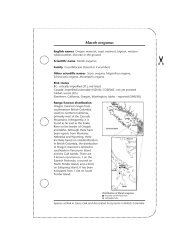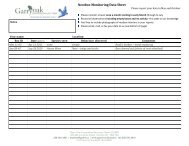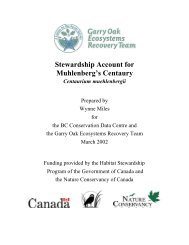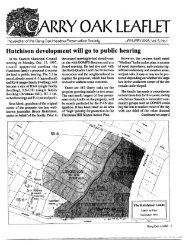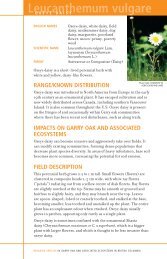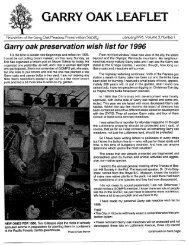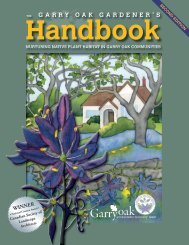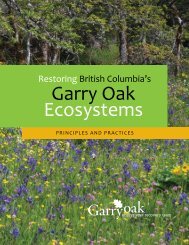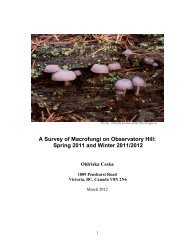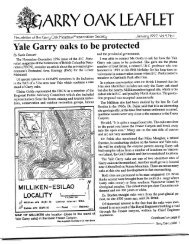PDF 320KB - Garry Oak Ecosystems Recovery Team
PDF 320KB - Garry Oak Ecosystems Recovery Team
PDF 320KB - Garry Oak Ecosystems Recovery Team
Create successful ePaper yourself
Turn your PDF publications into a flip-book with our unique Google optimized e-Paper software.
In the spring of 2009, I established 60 one-meter-square experimental<br />
plots at the Nature Conservancy of Canada’s Cowichan <strong>Garry</strong> <strong>Oak</strong><br />
Preserve near Duncan, BC. I collected base-line data of the abundance<br />
and diversity of plant species using a grid method. I measured and<br />
recorded the height, and counted the number of fruits, number of<br />
aborted fruits and number of aborted flowers for all mature blue camas<br />
plants within my plots. In the summer of 2009, I experimentally<br />
introduced the harvest of blue camas bulbs into my sites at three<br />
different intensities (0%, 50%, and 100%). Directly after all of the plots<br />
were harvested, I installed two cation and two anion PRS (Plant Root<br />
Simulator) nutrient probes into each plot. I am currently in the<br />
process of collecting data regarding soil pH, moisture, compaction and<br />
temperature.<br />
During the spring and summer of 2010, I will re-sample plant species<br />
abundance and diversity, as well as camas demographics in all sixty<br />
plots. After the blue camas has gone to seed, all mature blue camas<br />
bulbs will be harvested and weighed from half (30) of the total plots.<br />
The remainder of the camas bulbs in these 30 plots will be dug up,<br />
counted by species and weighed.<br />
In addition to my field study, I am also conducting interviews during<br />
the spring of 2010. The proposition of integrating blue camas harvesting<br />
practices with existing restoration and management initiatives in <strong>Garry</strong><br />
oak ecosystems raises questions regarding the current interest,<br />
opportunities, challenges and potential approaches to making this<br />
integration a reality. To investigate these issues I will interview<br />
interested individuals and land managers from Vancouver Island First<br />
Nations and non-First Nations communities. I will also organize an<br />
informal focus group discussion with interested First Nations and non-<br />
First Nations land managers (and others with an interest in the<br />
research). This discussion will explore possible strategies to introducing<br />
alternative forms of management, such as co-management, and<br />
harvesting of blue camas bulbs into Vancouver Island parks and<br />
preserves.<br />
Beckwith, B.R. 2004. The Queen Root of this Clime: Ethnoecological<br />
Investigations of Blue Camas (Camassia leichtlinii, C. quamash:<br />
Liliaceae) and its Landscapes on Southern Vancouver Island, British<br />
Columbia. PhD. Dissertation. University of Victoria, British Columbia.<br />
<strong>Garry</strong> <strong>Oak</strong> <strong>Ecosystems</strong> <strong>Recovery</strong> <strong>Team</strong> – Research Colloquium 2010 Page 27




